InterviewSolution
Saved Bookmarks
This section includes InterviewSolutions, each offering curated multiple-choice questions to sharpen your knowledge and support exam preparation. Choose a topic below to get started.
| 701. |
মান নির্ণয় করো : (a^(1/(x-y)))^(1/(x-z))xx(a^(1/(y-z)))^(1/(y-x))xx(a^(1/(z-x)))^(1/(z-y)) |
|
Answer» |
|
| 703. |
The mean of 15 observations is 32. Find the resulting mean, if each observation is increased by 60% |
|
Answer» |
|
| 704. |
Classify the following polynomials into linear quadratic and cubic polynomials : 9t^(2) |
|
Answer» |
|
| 705. |
When x^(3) + 64 is divided by x+4, the quotient is ……… . |
|
Answer» `(x-4)` |
|
| 706. |
Write the coordinates of the point where the graph of the equation5x+2y =10 intersect both the axes |
|
Answer» |
|
| 707. |
Draw the graph ofthe straight line given by equation 5x+6y=30 . Use this graph to find the area of the triangle by this line and the co-ordinate axes. |
|
Answer» `rArr` 5x=30-6y `rArr x=6-(6)/(5)Y` For easy calculation we will take the values of y as a MULTIPLE of 5 Let y = 0 `rArr` x=6 Let y = 5 `rArr` x=0 Lety=10 `rArr` =-6 Tables for values:  PLot the points A (6,0), B (0,5) and C (-6, 10) on the same graph paper, DRAW a straight line through these points 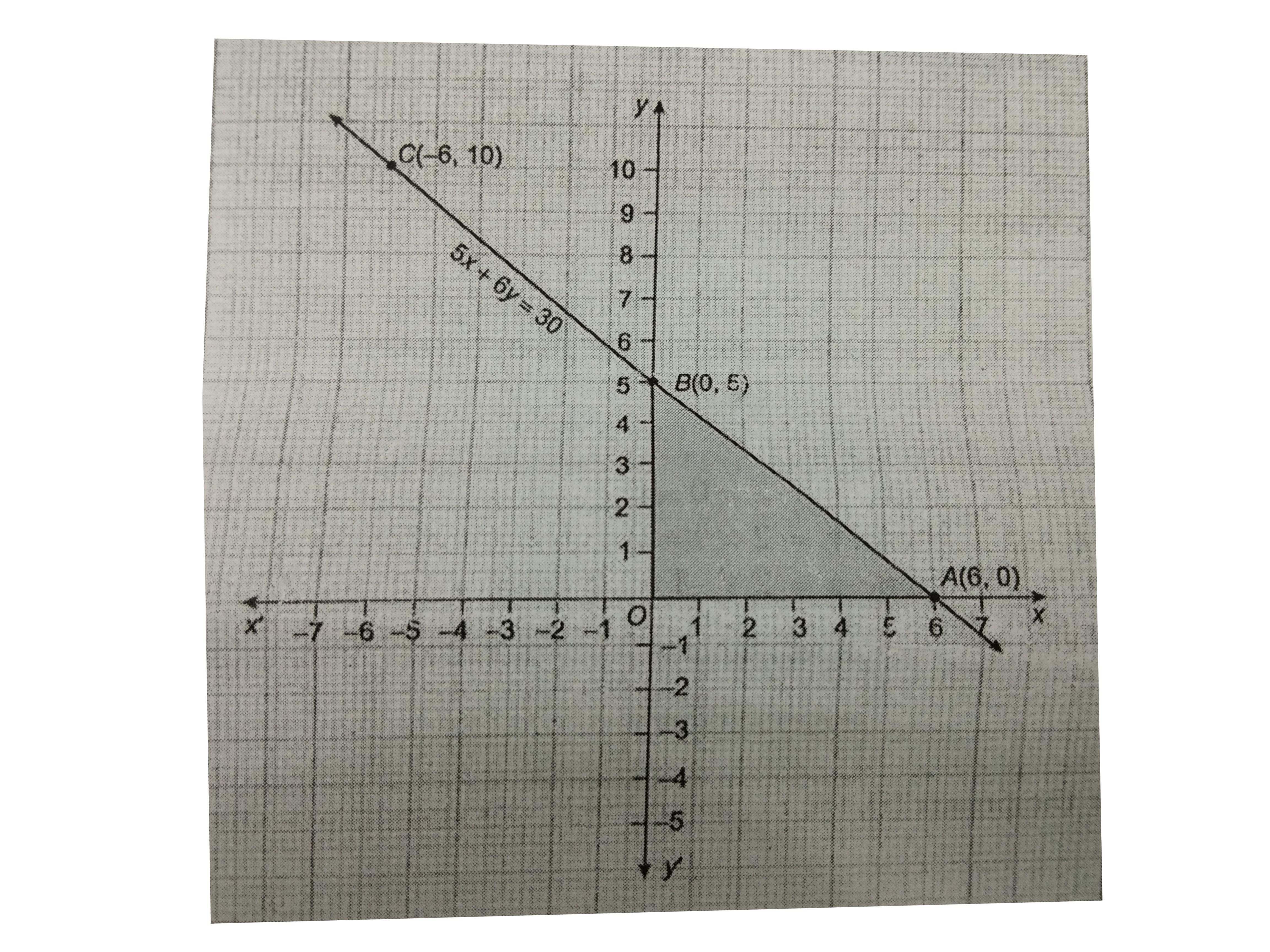
|
|
| 708. |
The radius of a spherical balloon increases from 7 cmto 14 cm as air is being pumped into it. Find the ratio of surface areas ofthe balloon in the two cases. |
|
Answer» |
|
| 709. |
Evaluate the following uing suitable identities : (998)^(3) |
|
Answer» |
|
| 710. |
The marks obtained (out of 100) by a class of 80 students are given below |
|
Answer» Solution :In the GIVEN frequency distribution, class sizes are different. So, we calculate the adjusted frequency for each class, Here, minimum size=20-10=10 We use the formula, Adjusted frequency of a class = `("Minimum class size")/("Class size of this class") xx "its frequency"` The modified table for frequency distribution is given below. 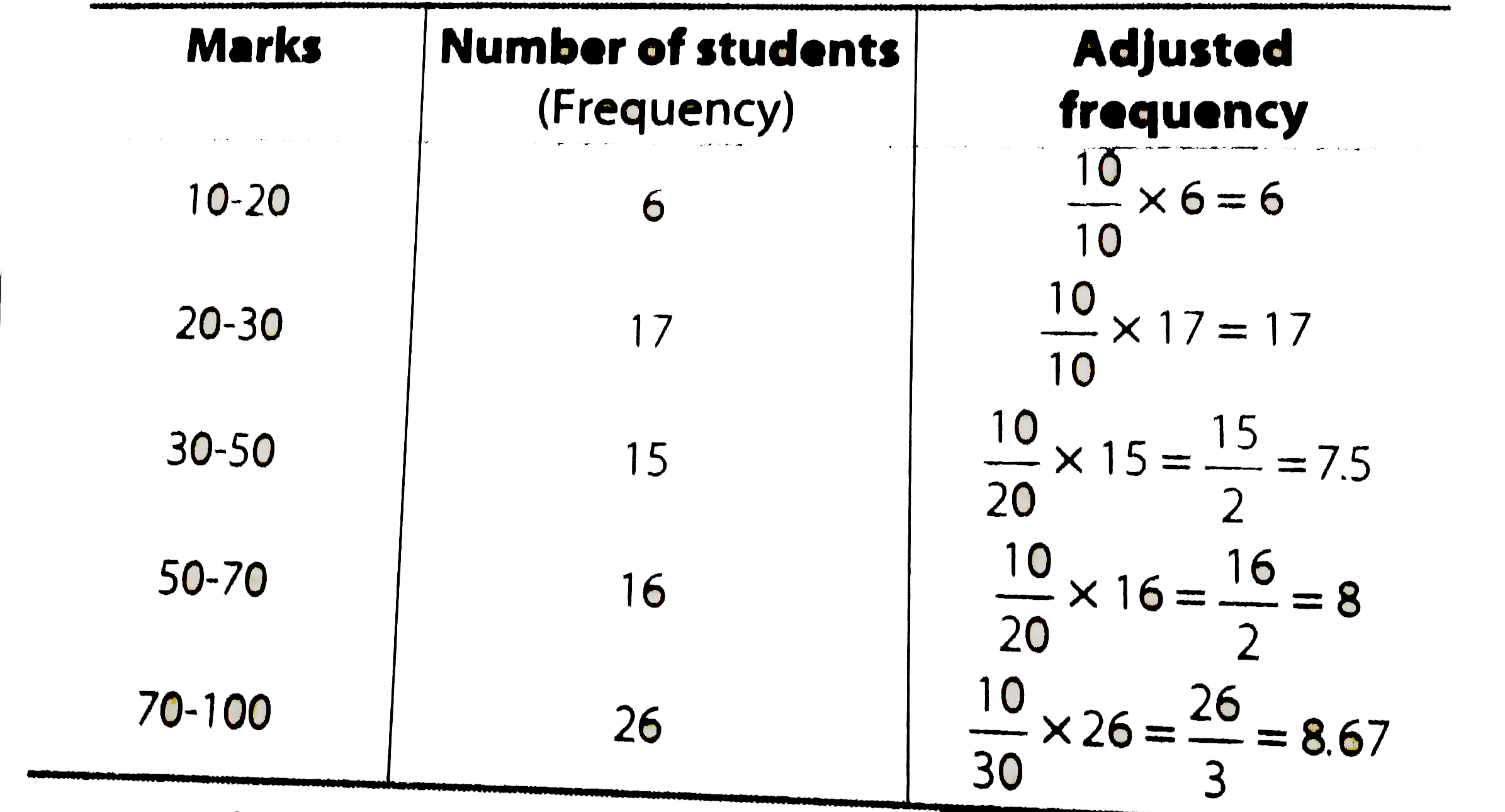 Along the HORIZONTAL axis, we represent the class intervls marks on some suitable scale. The corresponding frequencies of number of students are represented along the vertical axis on a suitable scale. Since, the given intervals start with 10-20. It means that, there is some BREAK INDICATED near the origin to slightly the graph is drawn with a scale beginning at 10. Now, we draw rectangles with class intervals as the bases and the corresponding adjusted frequencies as heights. A histogram of the given distribution is given below. 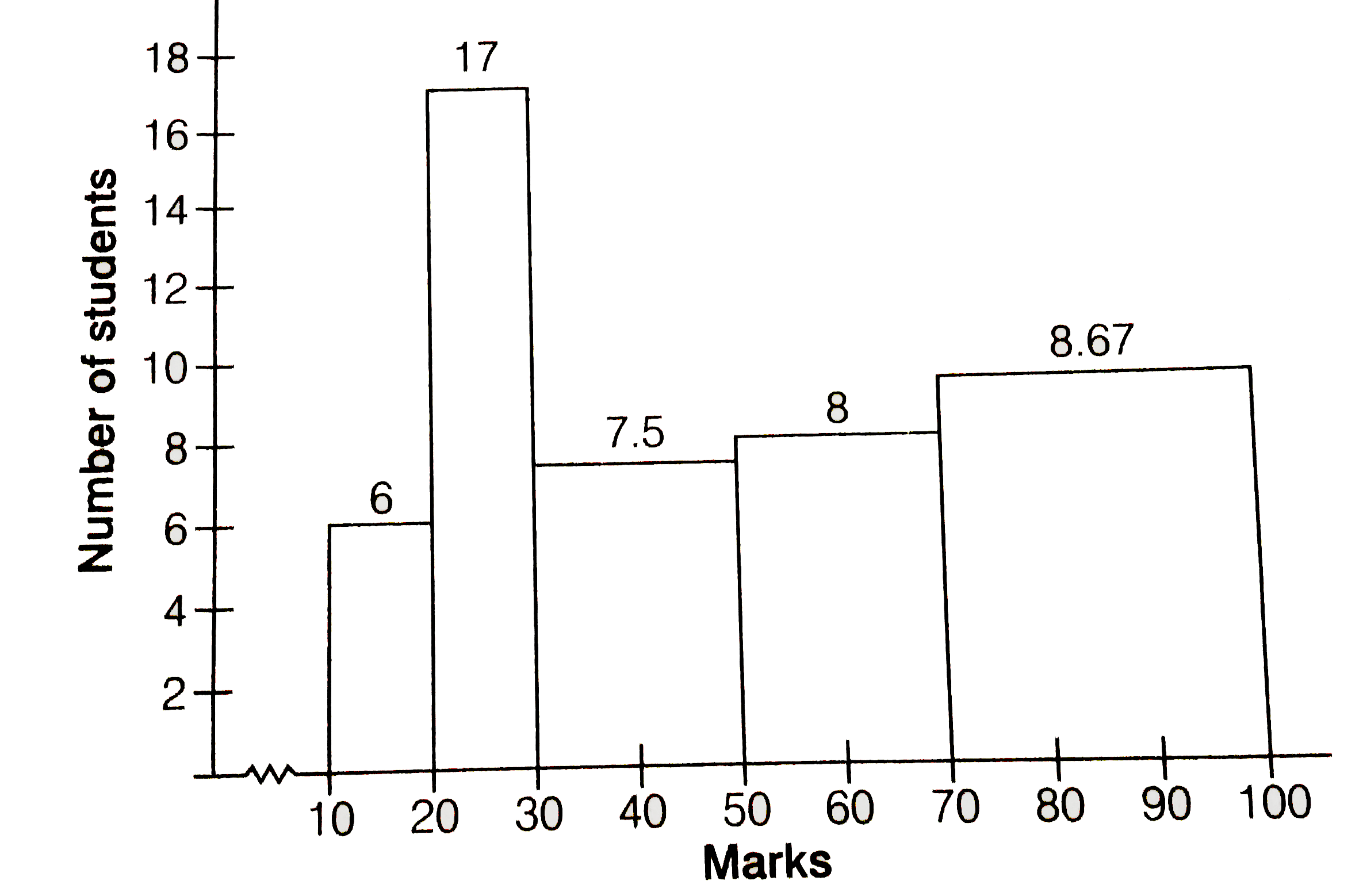
|
|
| 711. |
Construct trianglePQR in which angleP=96^(@), angleQ=40^(@) and PQ+PR=6 cm. |
|
Answer» SOLUTION :Step 1:Draw a LINE segment `bar(RS) = 6`cm. Step 2: Draw `bar(RX)`, such that `angleSRX=44^(@)`. Step : Draw `bar(SY)`, such that `angleRSY=1/2angleP=48^(@)`, intersecting `bar(RX)` at `Q`. Step 4: Draw the perpendicular bisector of `QS` to intersect `RS` at `P.` Step 5: Join `P` and `Q`. `PQR` is the required triangle. 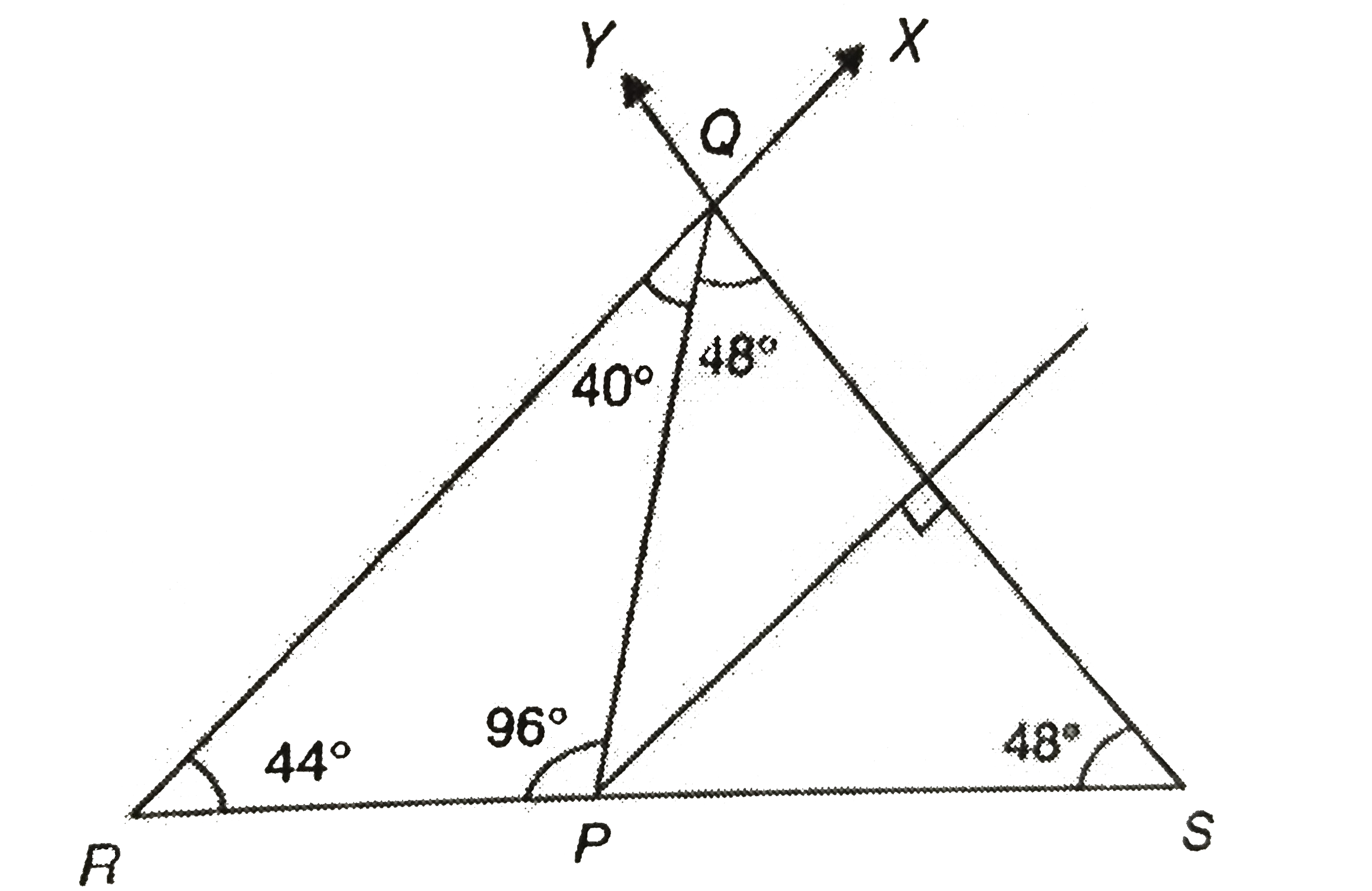
|
|
| 712. |
If two identical coins are tossed simultaneously. Find (a) the possible outcomes,(b) the number of total outcomes,(c) the probability of getting two heads, (d) probability of getting atleast one head, (e) probability of getting no heads and (f) probability of getting only one head. |
|
Answer» |
|
| 713. |
Classify the following numbers as rational or irrational. (2sqrt7)/(7sqrt7) |
|
Answer» |
|
| 714. |
If two integers a and b be such that -2 lt a lt 0 and 0 lt b lt 2, then show that (i) (a +b)belongs to the set of whole numbers W : (ii) (b-a) belongsto the set of natural numbers N : (iii)(a-b)belongsto the set of integers Z . |
|
Answer» (i) W (II) N . (III)Z . |
|
| 716. |
A sum is split into five equal parts. Each part is lent at annual rate of simple interest of 8%, 7%, 5%, 3% and 2%. They are lent for 1 year, 2 years, 3 years, 4 years and 5 years. On how many parts is the simple interest at least 25% of the total interest? |
|
Answer» 1 ii) `25%` of `5x=Rs(5x)/4`. iii) Find the interest on each sum of Rs `X` using given data, and check which is greater than `(5x)/4`. |
|
| 718. |
Write the following cubes in the expended from (i) (2a + 3b) ^(3) (ii) (2p -5) ^(3) |
|
Answer» <P> |
|
| 719. |
In triangleXYZ, XZ is the hypotenuse.If XY = 8 cm and YZ=12 cm, then ar(XYZ)= ____ cm^2 |
|
Answer» 20 |
|
| 720. |
A lead pencil consists of a cylinder of wood with asolid cylinder of graphite filled in the interior. The diameter of the pencilis 7 mm and the diameter of the graphite is 1 mm. If the length of the pencilis 14 cm, find the volume of the wood |
|
Answer» |
|
| 721. |
(a) Write the probabilityof getting each number on the top face when a die was rolled in the following table. (b) Find the sum of the probabilities of all outcomes. |
|
Answer» |
|
| 722. |
Three vertices of a parallelogram are A(-2,2), B(6,2),C(4,-3). Plot these points on a graph paper and hence use it to find co-ordinate of the fourth vertex D. Also, find the co-ordinates of the mid-point of the side CD. What is the area of the parallelogram ? |
|
Answer» Solution :Plot the points `A(-2,2), B(6,2)` and `C(4,-3)` as usual. COMPLETE the parallelogram ABCD. From the graph, the co-ordinates of the point D are `(-4,-3)`. The co-ordinates of the mid-points M of CD are `(0,-3)`. From the FIGURE, CD=8 units and the height of the parallelogram ABCD corresponding to the side CD=5 units. `therefore` The area of parallelogram ABCD = (`8xx5`) sq.units =40sq.units 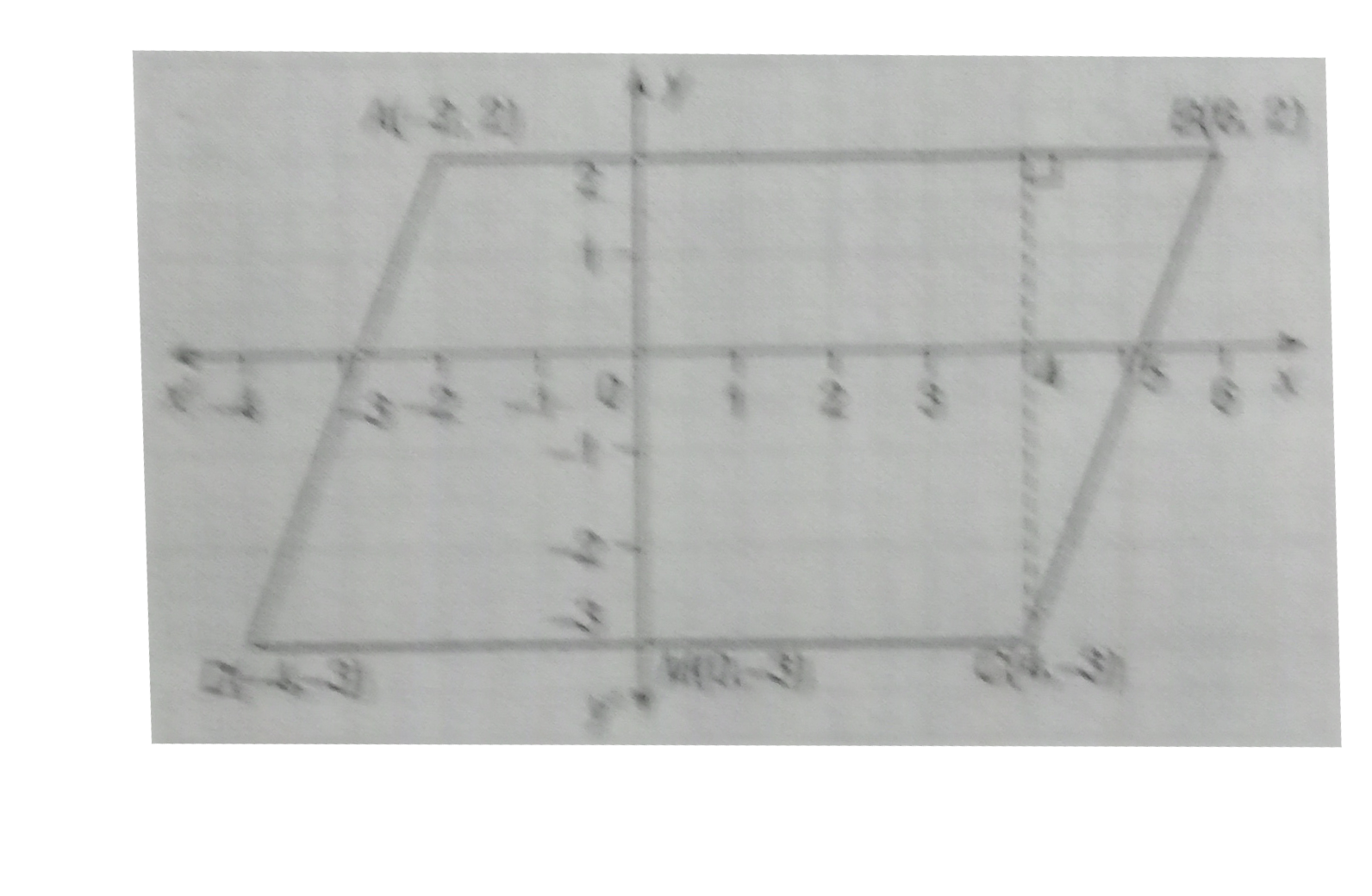
|
|
| 723. |
Draw an angle of 60^(@). Draw its bisector. |
|
Answer» <P> Solution :Steps of construction :1. Draw a line segment `AB.` 2. Draw an angle of `60^(@)`. 3. With `P` as CENTRE and a convinient radius draw an arc. 4. With `Q` as centre and with the same radius draw ANOTHER arc cutting the previous arc at `D.` Join `AD.` Then `AD` is the required bisector of `angleBAC`. 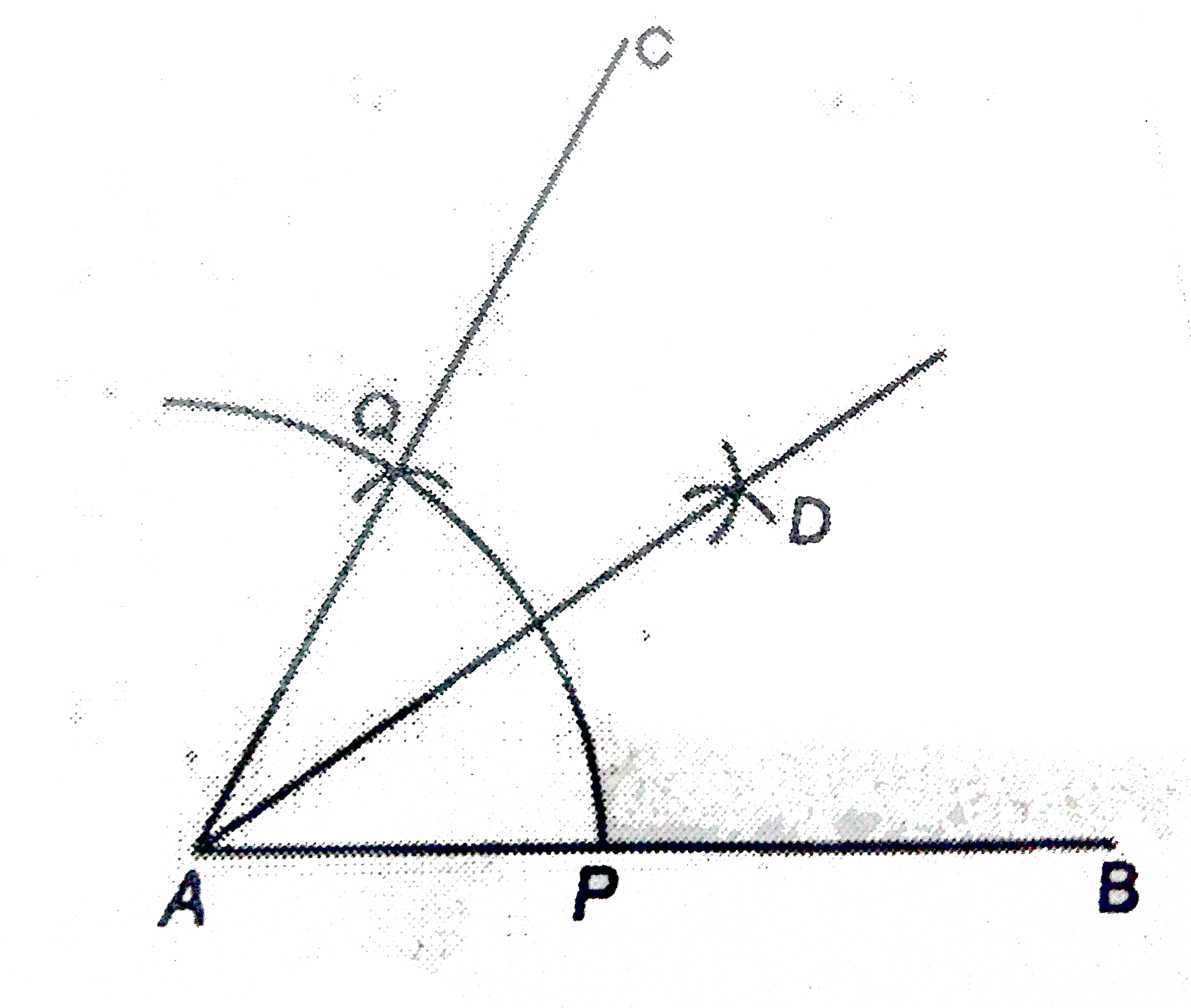
|
|
| 724. |
Select the correct answer (MCQ) : (vi) log_(a)log_(a)log_(a^(a^(a^(a^a))))= |
|
Answer» 1 |
|
| 725. |
Construct an angle of 67.5^(@) by using the ruler and compasses. |
| Answer» SOLUTION :`(67.5)^(@)=1/2 XX(135)^(@)=1/2 xx(90^(@)+45^(@))`. | |
| 726. |
Ray AX is the bisector of angleBAC and ray AY is the bisector of angleXAC. If angleBAY=60^(@), find angleBAC. |
|
Answer» |
|
| 727. |
From the choices given below choose the equation whose graphs are given in fig (a) and fig(b) For fig (a) (i) y=x (ii)x+y=0 (iii)y=2x (iv)2+3y=7xFor fig (b) (i) y=x+2 (ii)y=x-2 (iii)y=-x+2 (iv)x+2 |
|
Answer» Solution :In FIG (a) we observe that the points (-1,1) SATISFY the EQUATION x+y =0 At (-1,1), x+y=-1+1=0 and at (1,-1) , x+y=1-1=0 In fig (B) we observe that the points (-1,3),(0,2) and (2,0) and (2,0) satisfy the equation uy =-x+2 , x+y =2. (At (-1,3), x+y =-1 +(+3)=2 At (0,2), x+y=0+2=2 and at (2,0) , x+y = 2+0=2 |
|
| 728. |
Construct a Delta ABC in which BC=5.6 cm, angleB=30^(@) and (AB-AC)=3 cm. Measure AB and AC. Justify your construction. |
|
Answer» Solution :STEPS OF CONSTRUCTION (i) Draw `BC=5.6` cm. (ii) Construct `angleCBX=30^(@)`. (III) ALONG `BX`, set off `BD=3` cm. (iv) Join `CD`. (v) Draw the right bisector of `CD`, meeting `BD` produced at `A`. (vi) Join `AC`. Then, `Delta ABC` is the required triangle. Verification : On measuring, we FIND that `AB=6.1` cm and `AC=3.1` cm. `:. (AB-AC)=(6.1-3.1) cm =3` cm. Justification : Since `A` lies on the perpendicular bisector of `CD`, we have `AD=AC`. Now, `BD=3` cm `implies AB-AD=3` cm `implies AB-AC=3 cm ""[ :' AD=AC]` HENCE, `Delta ABC` is the required triangle. 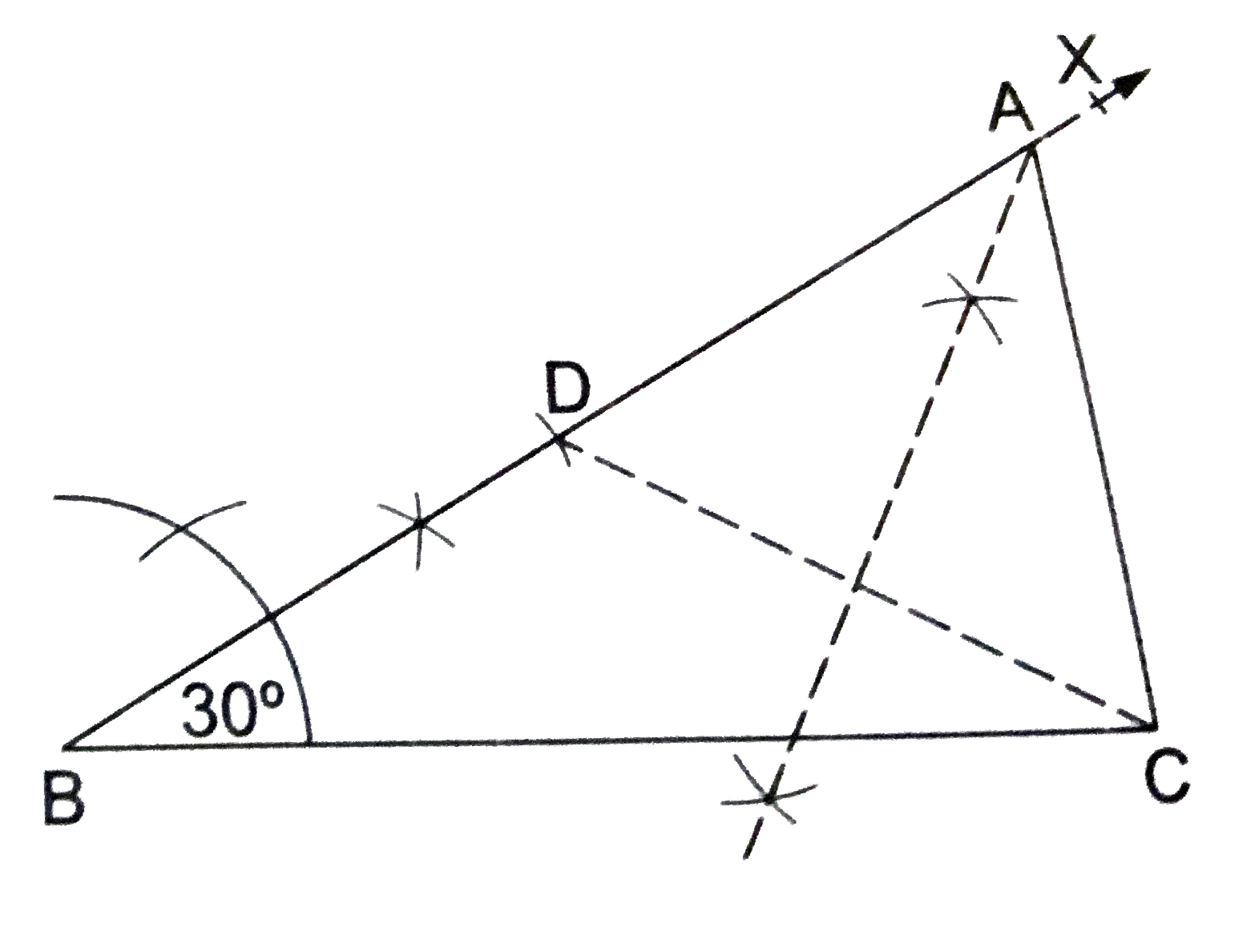
|
|
| 729. |
A sum of Rs 150 is borrowed at simple interest at 4% per annum for the month, 8% per annum for the second month, 12% per annum for the third month, and so on. What is the total amount of interest to be paid at the end of 6 months? |
| Answer» SOLUTION :RS 10.50 | |
| 730. |
If each sides of a triangle is doubled then how many times the perimeter of triangle increased? |
|
Answer» |
|
| 731. |
Euclid stated that all right angles are equal to each other in the form of |
|
Answer» a DEFINITION |
|
| 732. |
Use the factor theorem to determine whether g(x) is a factor of p(x) in each of the following cases : p(x) = 2x^(3) + x^(2) - 2x-1 |
|
Answer» |
|
| 733. |
Kiran bought Rs.10 shares of a company. He received a rate of return which was one-third of the dividend rate he received. Market value of each share is _________. (in Rs.) |
|
Answer» Solution :(i) FIND the annual dividend from each share. (ii) First of all, find the market value of each share. (iii) USE, `"FV"xx"RD"="MV"xx"RR"`. |
|
| 734. |
Fill in the blanks : (i) Every real number is either . . . . . . . . . . . . . . .Number or . . . . . . . . . . . . . . . . number. (ii) The decimal representaion of rational number is either . . . . . . . . . . . . .or . . . . . . . . .. . . . . . (iii) The decimal representation of an irrational number is . . . . . . . . . . . . . . (iv) The sum of two rational numbers is always . . . . . . . . . . . . . |
|
Answer» |
|
| 736. |
If 4cos^(2)x=3 and x is an acute angle, find the value of : cos^(2)x+cot^(2)x |
|
Answer» |
|
| 737. |
rationalising the denominator: (6-4sqrt2)/(6+4sqrt2) |
|
Answer» |
|
| 739. |
P,Q and R together can complete 50% of a work in 2 days. All three start the work but after two days Q. left. P and R alone in 8 days. In how many days can P alone complete the work? |
|
Answer» 6 (iii) Let p,q nad r be the NUMBR of days taken by P,Q and R respectively. `(iii) (1)/(q)+(1)/(p)+(1)/(r)=(1)/(4)""(1)` `(1)/(p)+(1)/(r)=(1)/(6)""(2)` `(3)/(q)+(2)/(q)+(11)/(r)=1 ""(3)` (iv) SOVLE the above equations fo FIND the P |
|
| 740. |
In the given figure, AC is the diameter of the circle with center O. If angleADE = 30^(@), angleDAC = 35^(@) and angleCAB = 40^(@). Find (i) angleACD, (ii) angleACB, (iii) angleDAE |
|
Answer» |
|
| 741. |
Answer the following by a number or a word or a sentence : Find the value of 64^(1/2) |
|
Answer» |
|
| 742. |
Rain fall of a place in the week is 4 cm, 5 cm, 12cm, 3cm, 6cm, 8cm, 0.5cm. Find the average rainfall per day. |
|
Answer» |
|
| 743. |
angleP and angleQare supplementary angles. If angleP=angleQ-40^(@), then find angleP and angleQ. |
|
Answer» |
|
| 744. |
A is the centre of the circle and ABCD is a square. IfBD = 4cm then findthe radius of the circle |
|
Answer» |
|
| 745. |
Factorisethe following8p^(3) - (12)/(5) p^(2) + (6)/(25) p- (1)/(125) |
|
Answer» |
|
| 746. |
Draw the less than cumulative frequency curve for the following data: {:("Class Interval",f),(""10-14,10),(""15-19,8),(""20-24,15),(""25-29,20),(""30-34,25):} |
| Answer» | |
| 749. |
If (a+b)/(xa+yb) = (b+c)/(xy+yc) = (c+a)/(xc+ya)" where " x + y ne 0 anda + b + c ne 0, then each of these ratios is equal to |
|
Answer» 1 (II) Bach fraction is equal to the ratio of sum of the numerators and the sum of the DENOMINATORS of all the equivalent fractions. |
|
| 750. |
In the given figure ‘O’ is the centre of the circle andAB, CD are equalchords.If angleAOB = 70^@ . Find the angles of the DeltaOCD |
|
Answer» |
|